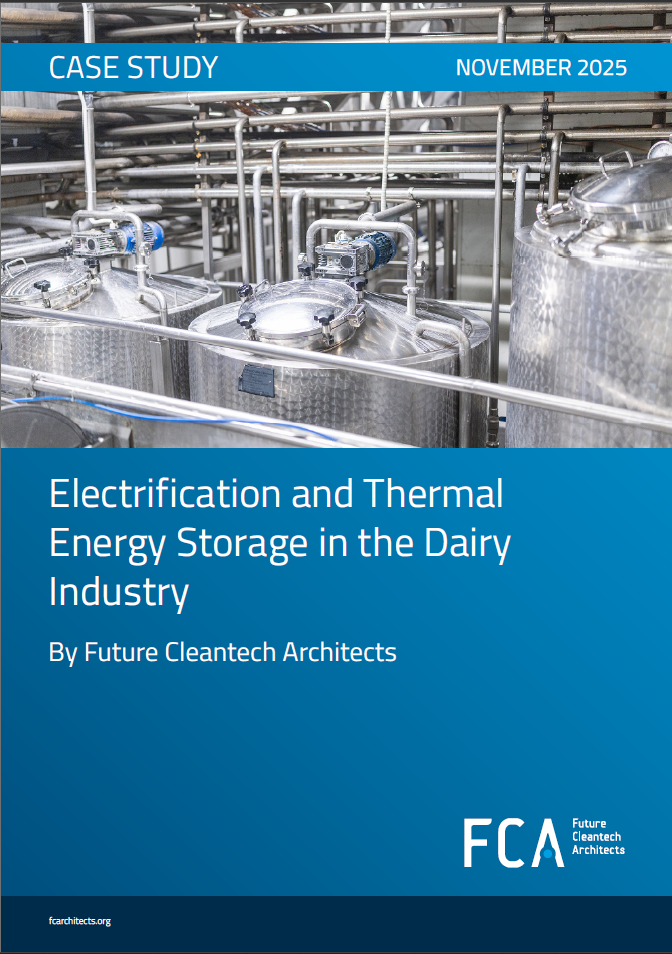Case Study: Electrification and Thermal Energy Storage in the Dairy Industry
Case Study: Electrification and Thermal Energy Storage in the Dairy Industry
The European dairy industry processes 150 million tonnes of raw milk per year, to produce a wide range of consumable products, including milks, cheeses, and yoghurts. Greenhouse gas emissions arise throughout the supply chain, including on-farm milk production, manufacturing operations, and the refrigeration and transportation of the final products. Among these, the processes necessary to pasteurize, standardize, and clarify the raw milk require significant amounts of heat, typically delivered at temperatures below 150°C. Currently, this heat is supplied by natural gas-fired boilers, and emits approximately 20 Mt CO₂eq per year.
This report presents a case study on the decarbonization of the dairy processing industry and the associated business case of heat electrification. The focus is solely on the currently gas-fired manufacturing processes; energy demand for refrigerated storage and transport is not considered. A nominally sized dairy processing facility located in Germany, is used as the reference case and a range of electricity and gas prices are considered. The findings from this analysis are relevant to the broader European food and beverage sector, which has similar heat demands and process temperature requirements.
Key Findings
The decarbonization of dairy processing facilities primarily involves replacing gas-fired
boilers with electric boilers or high-temperature heat pumps. Both technologies enable integration with thermal energy storage (TES), allowing plants to shift electricity consumption in response to fluctuating electricity prices. With a TES system providing five hours of discharge duration, it is shown facilities can perform twice-daily load shifting to reduce operational costs while maintaining continuous production.
Around 70% of a dairy facility’s total energy input is supplied as heat from natural gas combustion, with the remainder provided as electricity for auxiliary equipment. The pasteurization process dominates thermal demand, requiring heating of milk from 4°C to 75°C and subsequent cooling. These systems minimize net heat input by recovering much of the thermal energy during cooling, resulting in relatively small temperature lifts that are well suited to electrification.
Integrating TES enables load shifting by storing heat when electricity prices are low and discharging it during high-price periods, unlike gas-fired systems which lack interday price variability. Optimization of storage operation using hourly German electricity price data for 2024 showed that a TES system with five hours of capacity can reduce a facility’s average electricity cost by approximately 10 €/MWh. This reduction can significantly improve the competitiveness of electrification.
For most heat-electrification business cases with TES, the average electricity cost must be within 10 €/MWh of the gas price to achieve breakeven
within five years. This condition was not met in Germany in 2024, where wholesale electricity was approximately 40 €/MWh more expensive than gas. Retail electricity pricing structures often add a 40% premium to wholesale prices, extending breakeven periods and acting as barrier to electrification.
The electric boiler offers lower capital cost and a faster breakeven period, while the heat pump provides significantly lower lifetime costs. The breakeven year is largely independent of the discount rate, as in both cases the cost of energy input to the system (i.e., gas or electricity) is discounted similarly.
TES typically accounts for only 2-20% of total system capital cost, yet it can provide substantial operational benefits through load shifting. Per unit of stored energy, TES is five to ten times cheaper than lithium-ion batteries while offering comparable flexibility for short-term energy balancing. This makes TES a cost-effective enabler of heat electrification and a strategic lever for reducing overall energy costs in dairy processing and the wider food and beverage industry.
